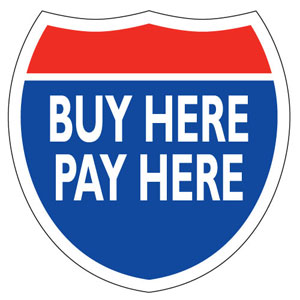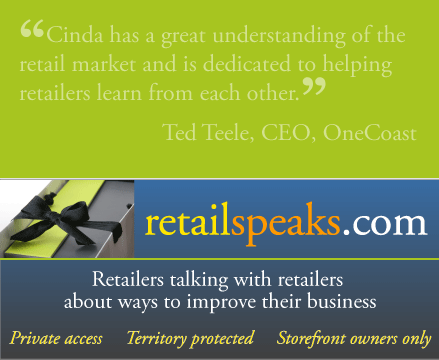 When “buy local”/”shop local” messaging hit its stride two years ago, big boxes and national chains quickly realized their corner on marketplace visibility was being eclipsed. Cost-conscious consumers were not only thinking about the price of an item, but the impact of where they purchased it. Before long, we saw mega-retailers repackaging the “buy local” message to include themselves—they’d procure broccoli from a nearby grower, then advertise themselves as part of the “local” movement. Carry meat packaged by a company located in a nearby town, then tell consumers they were buying “local.”
When “buy local”/”shop local” messaging hit its stride two years ago, big boxes and national chains quickly realized their corner on marketplace visibility was being eclipsed. Cost-conscious consumers were not only thinking about the price of an item, but the impact of where they purchased it. Before long, we saw mega-retailers repackaging the “buy local” message to include themselves—they’d procure broccoli from a nearby grower, then advertise themselves as part of the “local” movement. Carry meat packaged by a company located in a nearby town, then tell consumers they were buying “local.”
Uh yeah…not so much.
Well, Chapter Two of The Repackaging of Buy Local has begun to roll out, and it’s even more troubling.
To really understand its impact, we need to first remind ourselves what the phrase “buy local” was initially intended to mean. “Buy local,” “shop local,” local first,” and other similar tag lines focused on one of two things: The source of a product and/or the point of purchase—neither of which being a large, national corporate entity. These were “independent” businesses with no outside branded support. You know…the little guys.
When the economy slid south, then stayed there, consumers began thinking—actually thinking!–-about the impact of their spending habits. Sure, the majority are still frequenting big boxes for the best deal, but many have begun to recognize that convenience comes with its own price tag. Big boxes and national chains send their revenue out of town. Lots of it. Most of it. And that means less money for the folks who live in that community. For their fire department. The police department. The city streets.
Their quality of life.
Fast forward to Chapter Two.
Since the first attempt to jump on the local bandwagon fared poorly, a new game plan is being rolled out. Now, either on their own or with the help of community organizations, the message is being twisted by insinuation that “local” is all about location—which includes every single national chain and big box in town. This usurped version of “buy local” is being packaged as “Buy Mayberry” (or whatever the town’s name is), arguing that any purchase made with any business in town brings equal revenue home. Not so. Not even close.
Now…before someone begins throwing darts this direction…let me be clear. Not all “Buy Mayberry” programs include big boxes, franchises, and national chains. Many are built to support the merchants in town that are 100% locally owned, no national or regional branding, no outside corporate help. All local all the time. They give the most back. They should get the most attention.
But many are rolling out an ill-conceived message that spending with a nearby mega-store does as much financial good for the community as selecting an independent merchant. Which is simply not true.
From the study provided by Civic Economics:
For every $100 spent with a local, independent brick and mortar business, $68 returns to the local economy. Spend the same $100 with a big box or national chain and only $43 remains in the local economy.
Then, there’s the addition of internet sales, from The 3/50 Project:
Spend that same $100 online, and unless you live in the exact same community as the e-tailer, nothing comes home.
National chains bank out of town (for all but very few of us, out of state).
They don’t replenish business consumables via local stores.
They don’t bring new jobs to town; they displace that number of employees currently working for other local businesses.
When they make a charitable donation, it goes to the charity’s national office, not the local chapter (and certainly not the small non-profits who have no national office).
They don’t pay the same property tax rates small businesses do—theirs is negotiated lower.
They simply don’t put the money back into the town it comes from.
Yes, big boxes and national chains are here to stay, and yes, they play a role in the local economy. But I strongly advise any community considering a “Buy Mayberry” (or similar) promotion be very, very clear about who, exactly, it is they’re promoting.
If your plan includes big boxes and national chains, it’s not ”local.” It’s corporate. It’s about zip codes. And it will cost your community dearly long term.
That’s a pretty steep price to pay for short term, feel-good visibility.


Click here to tell me what you think....
I’m getting the word out aboutmy guitar lesson studio in Smyrna. How can Smyrna Independent Merchandisers help me as I’m providing a service locally. I have 35 students, looking for more as always.
Thank you so much Cinda! Everything you wrote is so true. It has been an amazing adventure for My Art Workshop to remain in business during the economic downturn. The only reason we are still in business is because of our loyal and conscience customers. I actually had a “regular” customer turn down a 20% off coupon in our store telling me she’d rather spend an extra 20% on our business to make sure we will be around for her next visit. Love, love, love our amazing customers!
Kristin Hill
Amazing article. This reaffirms my beliefs on supporting your local economy. This is why I shop at a local-brand coffee shop instead of the Bux. This is why I buy shoes at the local shoestore instead of Paying Less.
There is an actual independent, ‘mom and pop’ grocery store in the neighboring city, that mainly uses produce from local growers (granted, there are no Kiwi harvesters in Idaho…). I always have a better feeling when I shop there instead of a major chain.
Sure, these big box businesses generate jobs, but as you pointed out with the statistics it is still a bigger drain on local economies than exercising your option to shop local.
I’ll be sharing this post with the masses, if it’s ok. I think this message should be shared as much as humanly possible.
Please share away, Brandon; the more awareness out there, the better for each town striving to strengthen its economy and local business community.
well said! it’s so important to explain what shopping local actually MEANS these days!
i’m so thankful for fantastic customers who go out of their way not to shop elsewhere for what we sell. thanks, y’all!!
Hi Cinda, I’m confused why you call out franchise locations as something other than local businesses. As a former CMO of a franchise, the franchisee was in fact a local business person who paid a small percentage of their sales as royalties to offset training and the “system.” How is that somehow less?
@Bob,
I don’t “call out franchise locations as something other than local business.” As noted in every piece of marketing collateral and all over our website, The 3/50 Project’s focus is “independent” business—those who have absolutely no outside support or corporate benefit of any kind. As we know from the post above, “local” can be construed to include national brands, simply because of where they’re located.
A franchise typically (not always) is owned by someone in the area, but comes with many corporate benefits, depending on the chain it’s part of. The most obvious benefit is the nationally or regionally recognized brand name. Every time corporate rolls out a national ad, all franchises enjoy the “halo effect” without having to pay the hundreds of thousands of dollars it costs to produce and air a single 30 second TV spot or half page ad in a major newspaper.
Likewise, franchises enjoy additional benefits such as preferred vendors lists (manufacturers who offer significantly lower wholesale prices to franchise owners due to the volume the entire company does nationwide); a corporate office to call for advice on everything from advertising to lease renegotiation; and printed marketing materials that are pre-made—the franchise owner doesn’t have to hire a designer, find a local printer, and pour the full production expense into the materials out of their own pocket. All are benefits of being part of a large company who has the advantage of scale.
An independent, on the other hand, is too small on their own to negotiate huge volume pricing from vendors; enjoys no halo effect from national marketing campaigns; has no corporate headquarters phone number to call for advice; and receives no post-production marketing material. They are entirely on their own, with no outside support to help them out. (Otherwise, why would franchise owners pay franchise fees, percentages, and royalties? Tough to argue there aren’t benefits attached.)
Please keep in mind that we don’t, at any time, tell consumers franchises are bad or to steer clear of them. The 3/50 Project’s entire message is about balance—not ignoring the independent businesses who return a greater percentage of their revenue back into the community. None of their revenue funds a national or regional brand/chain.
We are diligently working to launch a community coalition program that will benefit locally owned businesses, the consumer and an appropriate non-profit. One of the benefits will be to help the merchant avoid giving up huge revenue share to Groupon and it’s competitors.
We love you guys. Keep up the good work. We started Brownsville Living which was a spin off on the idea of Keep Austin Weird a little over a year ago and we have had tremendous success encouraging locals to buy local, dine local, play local! This is an economic war between huge corporations and small towns and we can not afford to lose! Keep up the great work as we will also!
Brownsville Living. Be part of it.
Click here to tell me what you think....